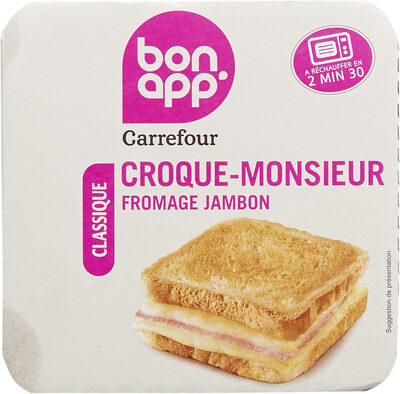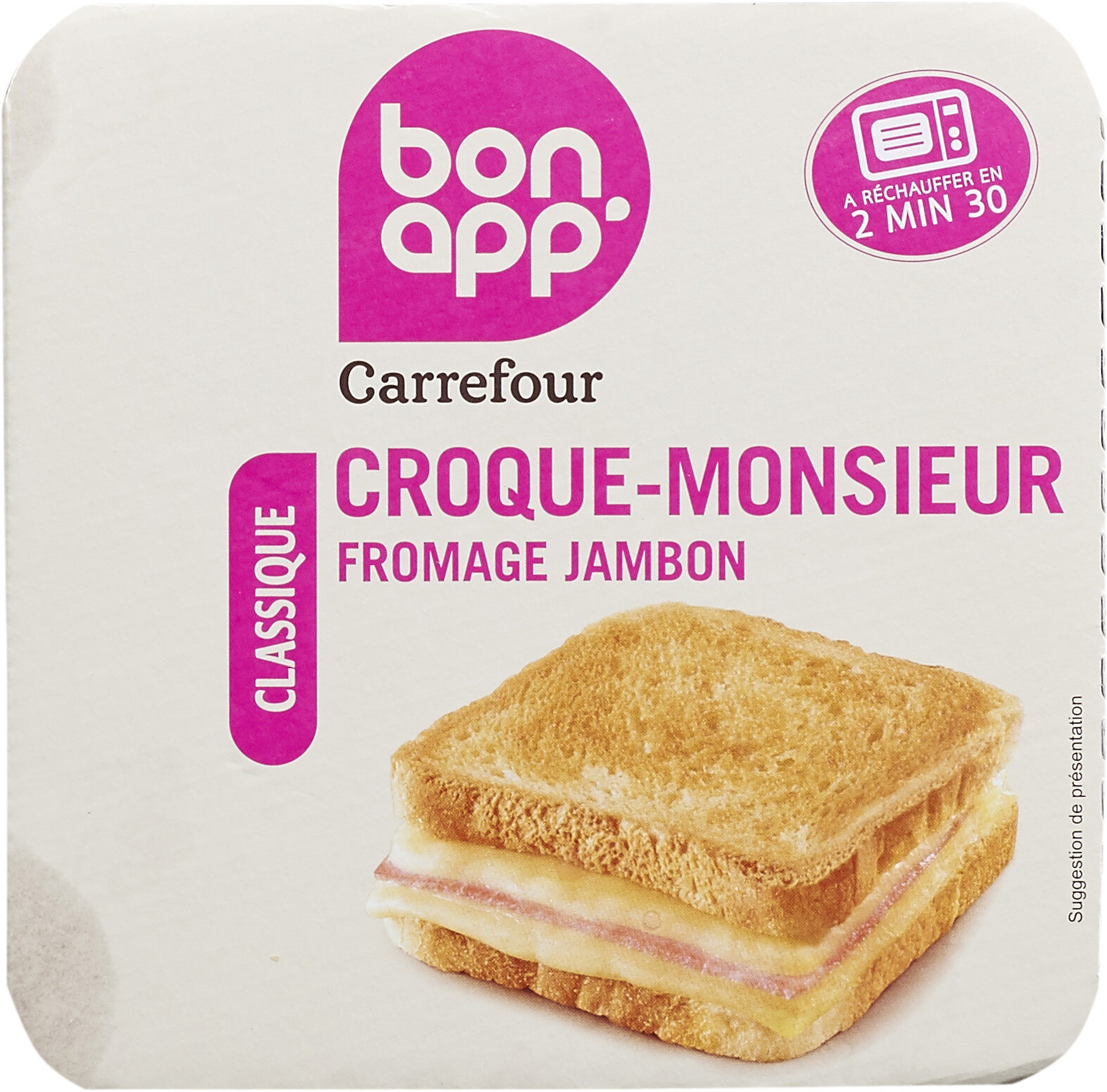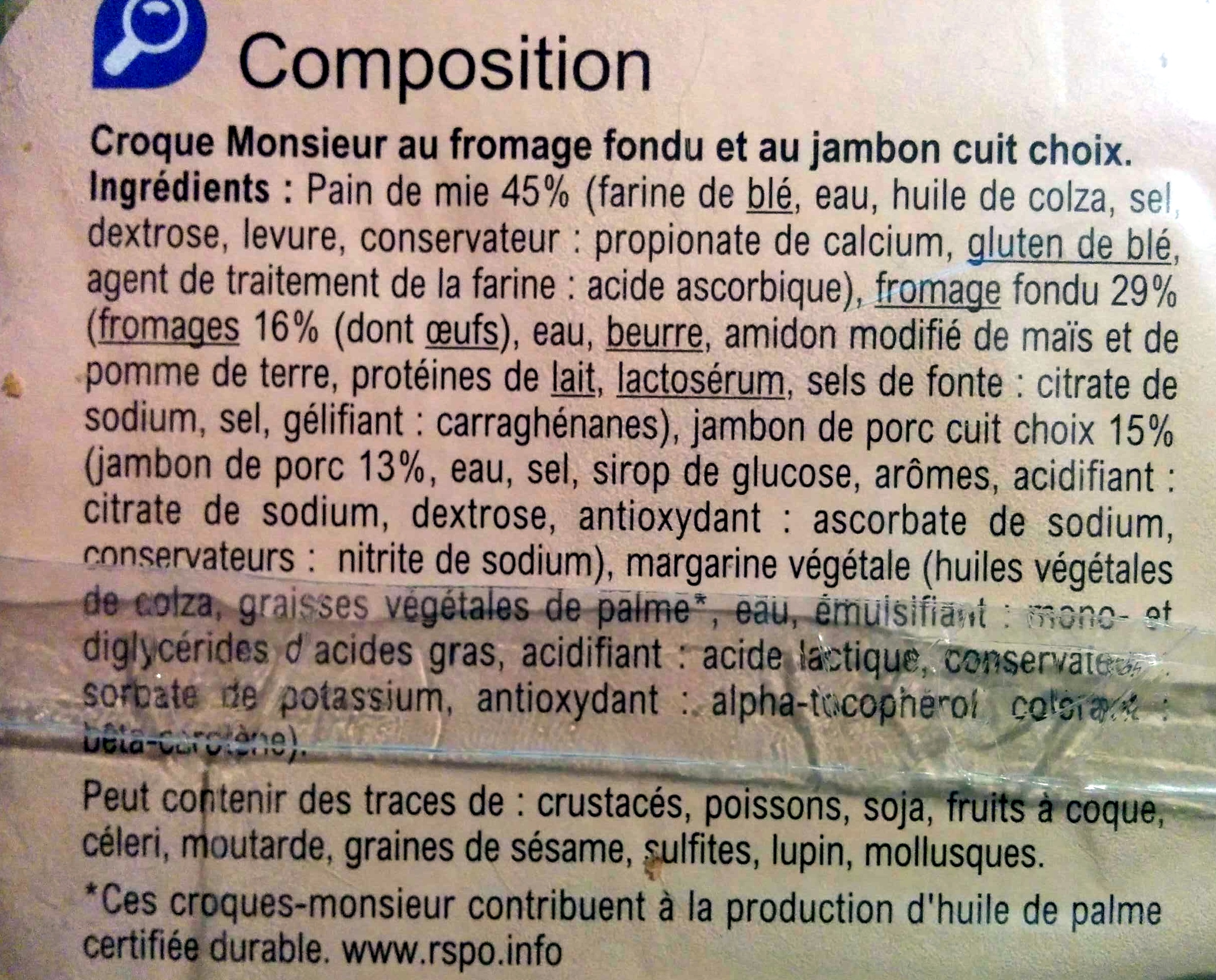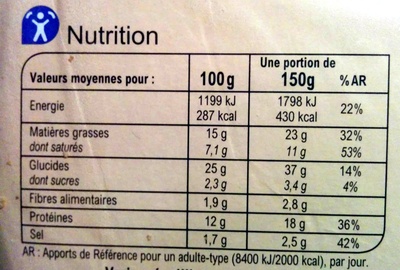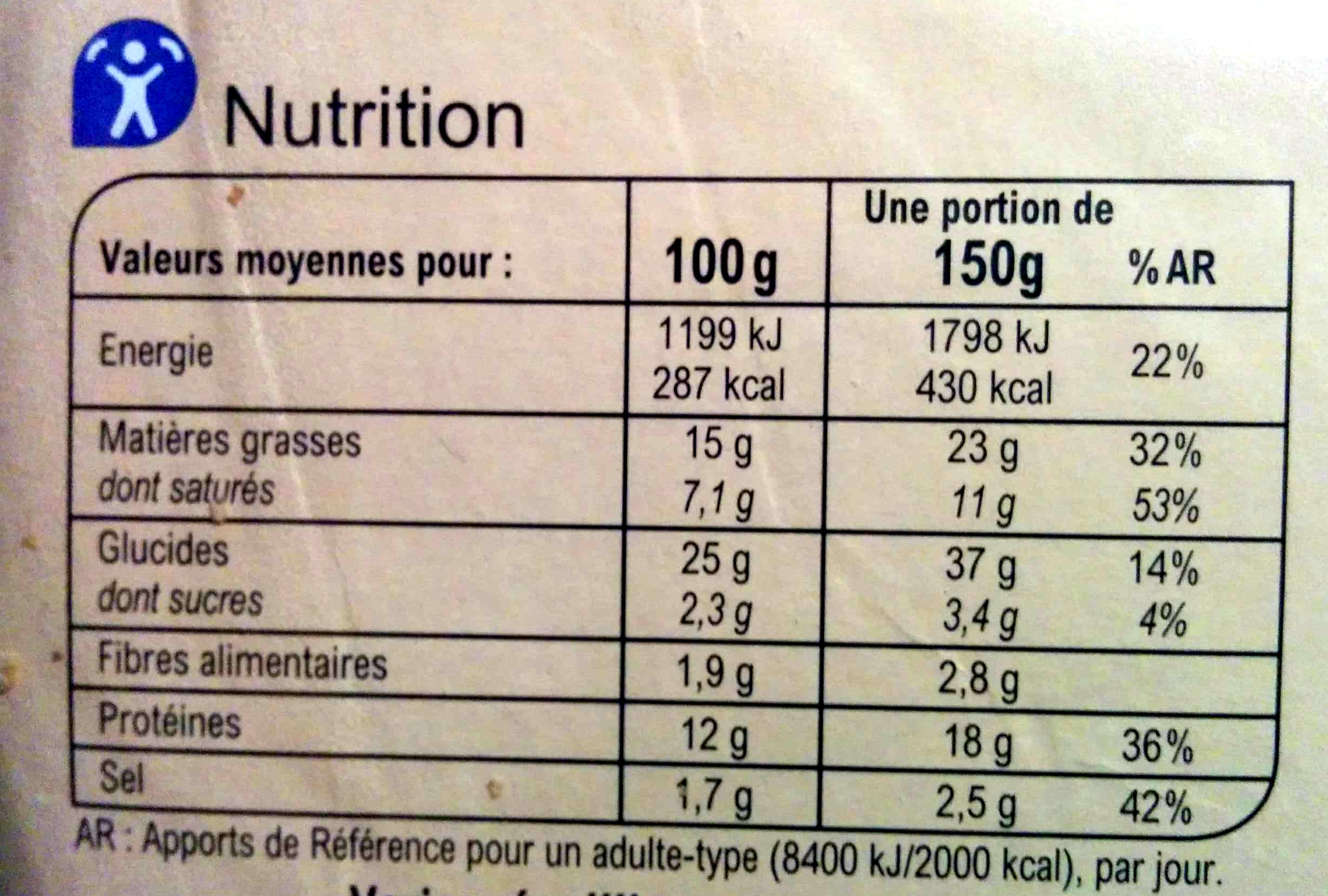Help us make food transparency the norm!
As a non-profit organization, we depend on your donations to continue informing consumers around the world about what they eat.
The food revolution starts with you!
Croque Monsieur Jambon Fomage - CARREFOUR BON APP - 150 g
Croque Monsieur Jambon Fomage - CARREFOUR BON APP - 150 g
This product page is not complete. You can help to complete it by editing it and adding more data from the photos we have, or by taking more photos using the app for Android or iPhone/iPad. Thank you!
×
Some of the data for this product has been provided directly by the manufacturer Carrefour.
Barcode: 3560070556496 (EAN / EAN-13)
Common name: Croque Monsieur au fromage fondu et au jambon cuit choix
Quantity: 150 g
Packaging: Plastic, Cardboard, fr:Papier sulfurisé
Brands: CARREFOUR BON APP
Categories: Sandwiches, Toasted ham sandwich topped with grated cheese
Labels, certifications, awards:
Sustainable, Sustainable Palm Oil, Green Dot, Made in France
Traceability code: FR 49.204.001 CE - Mesnil-en-Vallée (Maine-et-Loire, France)
Stores: Carrefour
Countries where sold: France
Matching with your preferences
Health
Ingredients
-
52 ingredients
: Pain de mie 45% (Farine de blé, eau, huile de colza, sel, dextrose, levure, CONSERVATEUR : Propionate de calcium, gluten de blé, agent de traitement de la farine : Acide ascorbique), fromage fondu 29% (Fromages 16% (Dont oeufs), eau, beurre, amidon modifié de maïs et de pomme de terre, protéines de lait, lactosérum, sels de fonte : Citrate de sodium, sel, GELIFIANT : Carraghénanes), jambon de porc cuit choix 15% (Jambon de porc 13%, eau, sel, sirop de glucose, arômes, ACIDIFIANT : Citrate de sodium, dextrose, ANTIOXYDANT : Ascorbate de sodium, CONSERVATEURS : Nitrite de sodium), margarine végétale (Huiles végétales de colza, graisses végétales de palme, eau, EMULSIFIANT : Mono et diglycérides d'acides gras, ACIDIFIANT : Acide lactique, CONSERVATEURS : Sorbate de potassium, ANTIOXYDANT : Alpha-Tocophérol, COLORANT : Bêta-CarotèneAllergens: Gluten, MilkTraces: Celery, Crustaceans, Fish, Lupin, Molluscs, Mustard, Nuts, Sesame seeds, Soybeans, Sulphur dioxide and sulphites
Food processing
-
Ultra processed foods
Elements that indicate the product is in the 4 - Ultra processed food and drink products group:
- Additive: E14XX - Modified Starch
- Additive: E160a - Carotene
- Additive: E407 - Carrageenan
- Additive: E471 - Mono- and diglycerides of fatty acids
- Ingredient: Colour
- Ingredient: Dextrose
- Ingredient: Emulsifier
- Ingredient: Flavouring
- Ingredient: Gelling agent
- Ingredient: Glucose
- Ingredient: Glucose syrup
- Ingredient: Gluten
- Ingredient: Milk proteins
- Ingredient: Whey
Food products are classified into 4 groups according to their degree of processing:
- Unprocessed or minimally processed foods
- Processed culinary ingredients
- Processed foods
- Ultra processed foods
The determination of the group is based on the category of the product and on the ingredients it contains.
Additives
-
E160a - Carotene
Carotene: The term carotene -also carotin, from the Latin carota, "carrot"- is used for many related unsaturated hydrocarbon substances having the formula C40Hx, which are synthesized by plants but in general cannot be made by animals -with the exception of some aphids and spider mites which acquired the synthesizing genes from fungi-. Carotenes are photosynthetic pigments important for photosynthesis. Carotenes contain no oxygen atoms. They absorb ultraviolet, violet, and blue light and scatter orange or red light, and -in low concentrations- yellow light. Carotenes are responsible for the orange colour of the carrot, for which this class of chemicals is named, and for the colours of many other fruits, vegetables and fungi -for example, sweet potatoes, chanterelle and orange cantaloupe melon-. Carotenes are also responsible for the orange -but not all of the yellow- colours in dry foliage. They also -in lower concentrations- impart the yellow coloration to milk-fat and butter. Omnivorous animal species which are relatively poor converters of coloured dietary carotenoids to colourless retinoids have yellowed-coloured body fat, as a result of the carotenoid retention from the vegetable portion of their diet. The typical yellow-coloured fat of humans and chickens is a result of fat storage of carotenes from their diets. Carotenes contribute to photosynthesis by transmitting the light energy they absorb to chlorophyll. They also protect plant tissues by helping to absorb the energy from singlet oxygen, an excited form of the oxygen molecule O2 which is formed during photosynthesis. β-Carotene is composed of two retinyl groups, and is broken down in the mucosa of the human small intestine by β-carotene 15‚15'-monooxygenase to retinal, a form of vitamin A. β-Carotene can be stored in the liver and body fat and converted to retinal as needed, thus making it a form of vitamin A for humans and some other mammals. The carotenes α-carotene and γ-carotene, due to their single retinyl group -β-ionone ring-, also have some vitamin A activity -though less than β-carotene-, as does the xanthophyll carotenoid β-cryptoxanthin. All other carotenoids, including lycopene, have no beta-ring and thus no vitamin A activity -although they may have antioxidant activity and thus biological activity in other ways-. Animal species differ greatly in their ability to convert retinyl -beta-ionone- containing carotenoids to retinals. Carnivores in general are poor converters of dietary ionone-containing carotenoids. Pure carnivores such as ferrets lack β-carotene 15‚15'-monooxygenase and cannot convert any carotenoids to retinals at all -resulting in carotenes not being a form of vitamin A for this species-; while cats can convert a trace of β-carotene to retinol, although the amount is totally insufficient for meeting their daily retinol needs.Source: Wikipedia
-
E160ai - Beta-carotene
Beta-Carotene: β-Carotene is an organic, strongly colored red-orange pigment abundant in plants and fruits. It is a member of the carotenes, which are terpenoids -isoprenoids-, synthesized biochemically from eight isoprene units and thus having 40 carbons. Among the carotenes, β-carotene is distinguished by having beta-rings at both ends of the molecule. β-Carotene is biosynthesized from geranylgeranyl pyrophosphate.β-Carotene is the most common form of carotene in plants. When used as a food coloring, it has the E number E160a. The structure was deduced by Karrer et al. in 1930. In nature, β-carotene is a precursor -inactive form- to vitamin A via the action of beta-carotene 15‚15'-monooxygenase.Isolation of β-carotene from fruits abundant in carotenoids is commonly done using column chromatography. It can also be extracted from the beta-carotene rich algae, Dunaliella salina. The separation of β-carotene from the mixture of other carotenoids is based on the polarity of a compound. β-Carotene is a non-polar compound, so it is separated with a non-polar solvent such as hexane. Being highly conjugated, it is deeply colored, and as a hydrocarbon lacking functional groups, it is very lipophilic.Source: Wikipedia
-
E202 - Potassium sorbate
Potassium sorbate (E202) is a synthetic food preservative commonly used to extend the shelf life of various food products.
It works by inhibiting the growth of molds, yeast, and some bacteria, preventing spoilage. When added to foods, it helps maintain their freshness and quality.
Some studies have shown that when combined with nitrites, potassium sorbate have genotoxic activity in vitro. However, potassium sorbate is generally recognized as safe (GRAS) by regulatory authorities.
-
E250 - Sodium nitrite
Sodium nitrite: Sodium nitrite is the inorganic compound with the chemical formula NaNO2. It is a white to slightly yellowish crystalline powder that is very soluble in water and is hygroscopic. It is a useful precursor to a variety of organic compounds, such as pharmaceuticals, dyes, and pesticides, but it is probably best known as a food additive to prevent botulism. It is on the World Health Organization's List of Essential Medicines, the most important medications needed in a basic health system.Nitrate or nitrite -ingested- under conditions that result in endogenous nitrosation has been classified as "probably carcinogenic to humans" by International Agency for Research on Cancer -IARC-.Source: Wikipedia
-
E270 - Lactic acid
Lactic acid: Lactic acid is an organic compound with the formula CH3CH-OH-COOH. In its solid state, it is white and water-soluble. In its liquid state, it is colorless. It is produced both naturally and synthetically. With a hydroxyl group adjacent to the carboxyl group, lactic acid is classified as an alpha-hydroxy acid -AHA-. In the form of its conjugate base called lactate, it plays a role in several biochemical processes. In solution, it can ionize a proton from the carboxyl group, producing the lactate ion CH3CH-OH-CO−2. Compared to acetic acid, its pKa is 1 unit less, meaning lactic acid deprotonates ten times more easily than acetic acid does. This higher acidity is the consequence of the intramolecular hydrogen bonding between the α-hydroxyl and the carboxylate group. Lactic acid is chiral, consisting of two optical isomers. One is known as L--+--lactic acid or -S--lactic acid and the other, its mirror image, is D--−--lactic acid or -R--lactic acid. A mixture of the two in equal amounts is called DL-lactic acid, or racemic lactic acid. Lactic acid is hygroscopic. DL-lactic acid is miscible with water and with ethanol above its melting point which is around 17 or 18 °C. D-lactic acid and L-lactic acid have a higher melting point. In animals, L-lactate is constantly produced from pyruvate via the enzyme lactate dehydrogenase -LDH- in a process of fermentation during normal metabolism and exercise. It does not increase in concentration until the rate of lactate production exceeds the rate of lactate removal, which is governed by a number of factors, including monocarboxylate transporters, concentration and isoform of LDH, and oxidative capacity of tissues. The concentration of blood lactate is usually 1–2 mM at rest, but can rise to over 20 mM during intense exertion and as high as 25 mM afterward. In addition to other biological roles, L-lactic acid is the primary endogenous agonist of hydroxycarboxylic acid receptor 1 -HCA1-, which is a Gi/o-coupled G protein-coupled receptor -GPCR-.In industry, lactic acid fermentation is performed by lactic acid bacteria, which convert simple carbohydrates such as glucose, sucrose, or galactose to lactic acid. These bacteria can also grow in the mouth; the acid they produce is responsible for the tooth decay known as caries. In medicine, lactate is one of the main components of lactated Ringer's solution and Hartmann's solution. These intravenous fluids consist of sodium and potassium cations along with lactate and chloride anions in solution with distilled water, generally in concentrations isotonic with human blood. It is most commonly used for fluid resuscitation after blood loss due to trauma, surgery, or burns.Source: Wikipedia
-
E282 - Calcium propionate
Calcium propanoate: Calcium propanoate or calcium propionate has the formula Ca-C2H5COO-2. It is the calcium salt of propanoic acid.Source: Wikipedia
-
E301 - Sodium ascorbate
Sodium ascorbate: Sodium ascorbate is one of a number of mineral salts of ascorbic acid -vitamin C-. The molecular formula of this chemical compound is C6H7NaO6. As the sodium salt of ascorbic acid, it is known as a mineral ascorbate. It has not been demonstrated to be more bioavailable than any other form of vitamin C supplement.Sodium ascorbate normally provides 131 mg of sodium per 1‚000 mg of ascorbic acid -1‚000 mg of sodium ascorbate contains 889 mg of ascorbic acid and 111 mg of sodium-. As a food additive, it has the E number E301 and is used as an antioxidant and an acidity regulator. It is approved for use as a food additive in the EU, USA, and Australia and New Zealand.In in vitro studies, sodium ascorbate has been found to produce cytotoxic effects in various malignant cell lines, which include melanoma cells that are particularly susceptible.Source: Wikipedia
-
E307 - Alpha-tocopherol
Alpha-Tocopherol: α-Tocopherol is a type of vitamin E. It has E number "E307". Vitamin E exists in eight different forms, four tocopherols and four tocotrienols. All feature a chromane ring, with a hydroxyl group that can donate a hydrogen atom to reduce free radicals and a hydrophobic side chain which allows for penetration into biological membranes. Compared to the others, α-tocopherol is preferentially absorbed and accumulated in humans.Source: Wikipedia
-
E331 - Sodium citrates
Sodium citrate: Sodium citrate may refer to any of the sodium salts of citrate -though most commonly the third-: Monosodium citrate Disodium citrate Trisodium citrateThe three forms of the salt are collectively known by the E number E331. Sodium citrates are used as acidity regulators in food and drinks, and also as emulsifiers for oils. They enable cheeses to melt without becoming greasy.Source: Wikipedia
-
E407 - Carrageenan
Carrageenan (E407), derived from red seaweed, is widely employed in the food industry as a gelling, thickening, and stabilizing agent, notably in dairy and meat products.
It can exist in various forms, each imparting distinct textural properties to food.
However, its degraded form, often referred to as poligeenan, has raised health concerns due to its potential inflammatory effects and its classification as a possible human carcinogen (Group 2B) by the International Agency for Research on Cancer (IARC).
Nevertheless, food-grade carrageenan has been deemed safe by various regulatory bodies when consumed in amounts typically found in food.
-
E471 - Mono- and diglycerides of fatty acids
Mono- and diglycerides of fatty acids (E471), are food additives commonly used as emulsifiers in various processed foods.
These compounds consist of glycerol molecules linked to one or two fatty acid chains, which help stabilize and blend water and oil-based ingredients. E471 enhances the texture and shelf life of products like margarine, baked goods, and ice cream, ensuring a smooth and consistent texture.
It is generally considered safe for consumption within established regulatory limits.
Ingredients analysis
-
Palm oil
Ingredients that contain palm oil: Palm fat
-
Non-vegan
Non-vegan ingredients: Melted cheese, Cheese, Egg, Butter, Milk proteins, Whey, fr:Jambon cuit choix, Ham
-
Non-vegetarian
Non-vegetarian ingredients: fr:Jambon cuit choix, Ham
-
Details of the analysis of the ingredients
: Pain de mie 45% (Farine de blé, eau, huile de colza, sel, dextrose, levure, CONSERVATEUR (Propionate de calcium), gluten de blé, agent de traitement de la farine (Acide ascorbique)), fromage fondu 29% (Fromages 16% (Dont oeufs), eau, beurre, amidon modifié de maïs et de pomme de terre, protéines de lait, lactosérum, sels de fonte (Citrate de sodium), sel, GELIFIANT (Carraghénanes)), jambon de porc cuit choix 15% (Jambon de porc 13%, eau, sel, sirop de glucose, arômes, ACIDIFIANT (Citrate de sodium), dextrose, ANTIOXYDANT (Ascorbate de sodium), CONSERVATEURS (Nitrite de sodium)), margarine végétale, Huiles végétales de colza, graisses végétales de palme, eau, EMULSIFIANT (mono- et diglycérides d'acides gras), ACIDIFIANT (Acide lactique), CONSERVATEURS (Sorbate de potassium), ANTIOXYDANT (Alpha-Tocophérol), COLORANT (Bêta-Carotène)- Pain de mie -> fr:pain-de-mie - percent_min: 45 - percent: 45 - percent_max: 45
- Farine de blé -> en:wheat-flour - vegan: yes - vegetarian: yes - ciqual_proxy_food_code: 9410 - percent_min: 5 - percent_max: 45
- eau -> en:water - vegan: yes - vegetarian: yes - ciqual_food_code: 18066 - percent_min: 0 - percent_max: 22.5
- huile de colza -> en:colza-oil - vegan: yes - vegetarian: yes - from_palm_oil: no - ciqual_food_code: 17130 - percent_min: 0 - percent_max: 15
- sel -> en:salt - vegan: yes - vegetarian: yes - ciqual_food_code: 11058 - percent_min: 0 - percent_max: 1.6999999782
- dextrose -> en:dextrose - vegan: yes - vegetarian: yes - ciqual_proxy_food_code: 31016 - percent_min: 0 - percent_max: 1.6999999782
- levure -> en:yeast - vegan: yes - vegetarian: yes - percent_min: 0 - percent_max: 1.6999999782
- CONSERVATEUR -> en:preservative - percent_min: 0 - percent_max: 1.6999999782
- Propionate de calcium -> en:e282 - vegan: yes - vegetarian: yes - percent_min: 0 - percent_max: 1.6999999782
- gluten de blé -> en:wheat-gluten - vegan: yes - vegetarian: yes - percent_min: 0 - percent_max: 1.6999999782
- agent de traitement de la farine -> en:flour-treatment-agent - percent_min: 0 - percent_max: 1.6999999782
- Acide ascorbique -> en:e300 - vegan: yes - vegetarian: yes - percent_min: 0 - percent_max: 1.6999999782
- fromage fondu -> en:melted-cheese - vegan: no - vegetarian: maybe - ciqual_proxy_food_code: 12999 - percent_min: 29 - percent: 29 - percent_max: 29
- Fromages -> en:cheese - vegan: no - vegetarian: maybe - ciqual_proxy_food_code: 12999 - percent_min: 16 - percent: 16 - percent_max: 16
- Dont oeufs -> en:egg - vegan: no - vegetarian: yes - ciqual_food_code: 22000 - percent_min: 16 - percent_max: 16
- eau -> en:water - vegan: yes - vegetarian: yes - ciqual_food_code: 18066 - percent_min: 1.625 - percent_max: 13
- beurre -> en:butter - vegan: no - vegetarian: yes - ciqual_proxy_food_code: 16400 - percent_min: 0 - percent_max: 9.66666666666667
- amidon modifié de maïs et de pomme de terre -> fr:amidons-modifies-de-mais-et-de-pomme-de-terre - vegan: yes - vegetarian: yes - ciqual_food_code: 9510 - percent_min: 0 - percent_max: 5.6875
- protéines de lait -> en:milk-proteins - vegan: no - vegetarian: yes - percent_min: 0 - percent_max: 3.79166666666667
- lactosérum -> en:whey - vegan: no - vegetarian: maybe - percent_min: 0 - percent_max: 2.84375
- sels de fonte -> en:emulsifying-salts - percent_min: 0 - percent_max: 2.275
- Citrate de sodium -> en:sodium-citrate - percent_min: 0 - percent_max: 2.275
- sel -> en:salt - vegan: yes - vegetarian: yes - ciqual_food_code: 11058 - percent_min: 0 - percent_max: 1.6999999782
- GELIFIANT -> en:gelling-agent - percent_min: 0 - percent_max: 1.6999999782
- Carraghénanes -> en:e407 - vegan: yes - vegetarian: yes - percent_min: 0 - percent_max: 1.6999999782
- Fromages -> en:cheese - vegan: no - vegetarian: maybe - ciqual_proxy_food_code: 12999 - percent_min: 16 - percent: 16 - percent_max: 16
- jambon de porc cuit choix -> fr:jambon-cuit-choix - vegan: no - vegetarian: no - ciqual_proxy_food_code: 28205 - percent_min: 15 - percent: 15 - percent_max: 15
- Jambon de porc -> en:ham - vegan: no - vegetarian: no - ciqual_proxy_food_code: 28205 - percent_min: 13 - percent: 13 - percent_max: 13
- eau -> en:water - vegan: yes - vegetarian: yes - ciqual_food_code: 18066 - percent_min: 0.25 - percent_max: 2
- sel -> en:salt - vegan: yes - vegetarian: yes - ciqual_food_code: 11058 - percent_min: 0 - percent_max: 1.6999999782
- sirop de glucose -> en:glucose-syrup - vegan: yes - vegetarian: yes - ciqual_proxy_food_code: 31016 - percent_min: 0 - percent_max: 0.875
- arômes -> en:flavouring - vegan: maybe - vegetarian: maybe - percent_min: 0 - percent_max: 0.583333333333333
- ACIDIFIANT -> en:acid - percent_min: 0 - percent_max: 0.4375
- Citrate de sodium -> en:sodium-citrate - percent_min: 0 - percent_max: 0.4375
- dextrose -> en:dextrose - vegan: yes - vegetarian: yes - ciqual_proxy_food_code: 31016 - percent_min: 0 - percent_max: 0.4375
- ANTIOXYDANT -> en:antioxidant - percent_min: 0 - percent_max: 0.291666666666667
- Ascorbate de sodium -> en:e301 - vegan: yes - vegetarian: yes - percent_min: 0 - percent_max: 0.291666666666667
- CONSERVATEURS -> en:preservative - percent_min: 0 - percent_max: 0.291666666666667
- Nitrite de sodium -> en:e250 - vegan: yes - vegetarian: yes - percent_min: 0 - percent_max: 0.291666666666667
- margarine végétale -> en:vegetable-margarine - vegan: yes - vegetarian: yes - percent_min: 1.22222222222222 - percent_max: 11
- Huiles végétales de colza -> en:colza-oil - vegan: yes - vegetarian: yes - from_palm_oil: no - ciqual_food_code: 17130 - percent_min: 0 - percent_max: 8.25925925925926
- graisses végétales de palme -> en:palm-fat - vegan: yes - vegetarian: yes - from_palm_oil: yes - ciqual_proxy_food_code: 16129 - percent_min: 0 - percent_max: 6.19444444444444
- eau -> en:water - vegan: yes - vegetarian: yes - ciqual_food_code: 18066 - percent_min: 0 - percent_max: 4.95555555555555
- EMULSIFIANT -> en:emulsifier - percent_min: 0 - percent_max: 4.12962962962963
- mono- et diglycérides d'acides gras -> en:e471 - vegan: maybe - vegetarian: maybe - from_palm_oil: maybe - percent_min: 0 - percent_max: 4.12962962962963
- ACIDIFIANT -> en:acid - percent_min: 0 - percent_max: 3.53968253968254
- Acide lactique -> en:e270 - vegan: yes - vegetarian: yes - percent_min: 0 - percent_max: 3.53968253968254
- CONSERVATEURS -> en:preservative - percent_min: 0 - percent_max: 3.09722222222222
- Sorbate de potassium -> en:e202 - vegan: yes - vegetarian: yes - percent_min: 0 - percent_max: 3.09722222222222
- ANTIOXYDANT -> en:antioxidant - percent_min: 0 - percent_max: 2.75308641975309
- Alpha-Tocophérol -> en:e307 - vegan: yes - vegetarian: yes - percent_min: 0 - percent_max: 2.75308641975309
- COLORANT -> en:colour - percent_min: 0 - percent_max: 2.47777777777778
- Bêta-Carotène -> en:e160ai - vegan: maybe - vegetarian: maybe - from_palm_oil: maybe - percent_min: 0 - percent_max: 2.47777777777778
- Pain de mie -> fr:pain-de-mie - percent_min: 45 - percent: 45 - percent_max: 45
Nutrition
-
Poor nutritional quality
⚠ ️Warning: the amount of fruits, vegetables and nuts is not specified on the label, it was estimated from the list of ingredients: 7This product is not considered a beverage for the calculation of the Nutri-Score.
Positive points: 1
- Proteins: 5 / 5 (value: 12, rounded value: 12)
- Fiber: 1 / 5 (value: 1.9, rounded value: 1.9)
- Fruits, vegetables, nuts, and colza/walnut/olive oils: 0 / 5 (value: 7.44444444444444, rounded value: 7.4)
Negative points: 17
- Energy: 3 / 10 (value: 1199, rounded value: 1199)
- Sugars: 0 / 10 (value: 2.3, rounded value: 2.3)
- Saturated fat: 7 / 10 (value: 7.1, rounded value: 7.1)
- Sodium: 7 / 10 (value: 679.99999128, rounded value: 680)
The points for proteins are not counted because the negative points are greater or equal to 11.
Nutritional score: (17 - 1)
Nutri-Score:
-
Nutrient levels
-
Fat in moderate quantity (15%)
What you need to know- A high consumption of fat, especially saturated fats, can raise cholesterol, which increases the risk of heart diseases.
Recommendation: Limit the consumption of fat and saturated fat- Choose products with lower fat and saturated fat content.
-
Saturated fat in high quantity (7.1%)
What you need to know- A high consumption of fat, especially saturated fats, can raise cholesterol, which increases the risk of heart diseases.
Recommendation: Limit the consumption of fat and saturated fat- Choose products with lower fat and saturated fat content.
-
Sugars in low quantity (2.3%)
What you need to know- A high consumption of sugar can cause weight gain and tooth decay. It also augments the risk of type 2 diabetes and cardio-vascular diseases.
Recommendation: Limit the consumption of sugar and sugary drinks- Sugary drinks (such as sodas, fruit beverages, and fruit juices and nectars) should be limited as much as possible (no more than 1 glass a day).
- Choose products with lower sugar content and reduce the consumption of products with added sugars.
-
Salt in high quantity (1.7%)
What you need to know- A high consumption of salt (or sodium) can cause raised blood pressure, which can increase the risk of heart disease and stroke.
- Many people who have high blood pressure do not know it, as there are often no symptoms.
- Most people consume too much salt (on average 9 to 12 grams per day), around twice the recommended maximum level of intake.
Recommendation: Limit the consumption of salt and salted food- Reduce the quantity of salt used when cooking, and don't salt again at the table.
- Limit the consumption of salty snacks and choose products with lower salt content.
-
-
Nutrition facts
Nutrition facts As sold
for 100 g / 100 mlAs sold
per serving (150 g)Compared to: Toasted ham sandwich topped with grated cheese Energy 1,199 kj
(287 kcal)1,800 kj
(430 kcal)+18% Fat 15 g 22.5 g +42% Saturated fat 7.1 g 10.6 g +33% Carbohydrates 25 g 37.5 g - Sugars 2.3 g 3.45 g -24% Fiber 1.9 g 2.85 g +14% Proteins 12 g 18 g +8% Salt 1.7 g 2.55 g +16% Fruits‚ vegetables‚ nuts and rapeseed‚ walnut and olive oils (estimate from ingredients list analysis) 7.444 % 7.444 % Carbon footprint from meat or fish 111 g 167 g
Environment
-
Eco-Score D - High environmental impact
⚠ ️Select a country in order to include the full impact of transportation.The Eco-Score is an experimental score that summarizes the environmental impacts of food products.→ The Eco-Score was initially developped for France and it is being extended to other European countries. The Eco-Score formula is subject to change as it is regularly improved to make it more precise and better suited to each country.Life cycle analysis
-
Average impact of products of the same category: C (Score: 52/100)
Category: Toasted ham sandwich topped with grated cheese
Category: Toasted ham sandwich topped with grated cheese
- PEF environmental score: 0.52 (the lower the score, the lower the impact)
- including impact on climate change: 4.42 kg CO2 eq/kg of product
Stage Impact Agriculture
75.9 %Processing
13.0 %Packaging
5.7 %Transportation
3.1 %Distribution
1.8 %Consumption
0.5 %
Bonuses and maluses
-
Missing origins of ingredients information
Malus: -5
⚠ ️ The origins of the ingredients of this product are not indicated.
If they are indicated on the packaging, you can modify the product sheet and add them.
If you are the manufacturer of this product, you can send us the information with our free platform for producers.
-
Ingredients that threatens species
Malus: -10
Contains palm oil
Tropical forests in Asia, Africa and Latin America are destroyed to create and expand oil palm tree plantations. The deforestation contributes to climate change, and it endangers species such as the orangutan, the pigmy elephant and the Sumatran rhino.
-
Packaging with a medium impact
Malus: -12
Shape Material Recycling Impact Unknown Paper Low Unknown Plastic High Unknown Cardboard Low ⚠ ️ The information about the packaging of this product is not sufficiently precise (exact shapes and materials of all components of the packaging).⚠ ️ For a more precise calculation of the Eco-Score, you can modify the product page and add them.
If you are the manufacturer of this product, you can send us the information with our free platform for producers.
Eco-Score for this product
-
Impact for this product: D (Score: 25/100)
Product: Croque Monsieur Jambon Fomage - CARREFOUR BON APP - 150 g
Life cycle analysis score: 52
Sum of bonuses and maluses: -27
Final score: 25/100
-
Carbon footprint
-
Equal to driving 2.3 km in a petrol car
442 g CO² per 100g of product
The carbon emission figure comes from ADEME's Agribalyse database, for the category: Toasted ham sandwich topped with grated cheese (Source: ADEME Agribalyse Database)
Stage Impact Agriculture
77.4 %Processing
8.1 %Packaging
8.8 %Transportation
4.7 %Distribution
0.8 %Consumption
0.2 %
Packaging
-
Packaging with a medium impact
-
Packaging parts
(Paper)
(Plastic)
(Cardboard)
-
Packaging materials
Material % Packaging weight Packaging weight per 100 g of product Paper or cardboard Plastic Total
-
Transportation
-
Origins of ingredients
Missing origins of ingredients information
⚠ ️ The origins of the ingredients of this product are not indicated.
If they are indicated on the packaging, you can modify the product sheet and add them.
If you are the manufacturer of this product, you can send us the information with our free platform for producers.Add the origins of ingredients for this product Add the origins of ingredients for this product
Threatened species
-
Contains palm oil
Drives deforestation and threatens species such as the orangutan
Tropical forests in Asia, Africa and Latin America are destroyed to create and expand oil palm tree plantations. The deforestation contributes to climate change, and it endangers species such as the orangutan, the pigmy elephant and the Sumatran rhino.
Report a problem
-
Incomplete or incorrect information?
Category, labels, ingredients, allergens, nutritional information, photos etc.
If the information does not match the information on the packaging, please complete or correct it. Open Food Facts is a collaborative database, and every contribution is useful for all.
Data sources
Product added on by phoenix
Last edit of product page on by packbot.
Product page also edited by date-limite-app, org-carrefour, quechoisir, quentinbrd, roboto-app, tacite.
